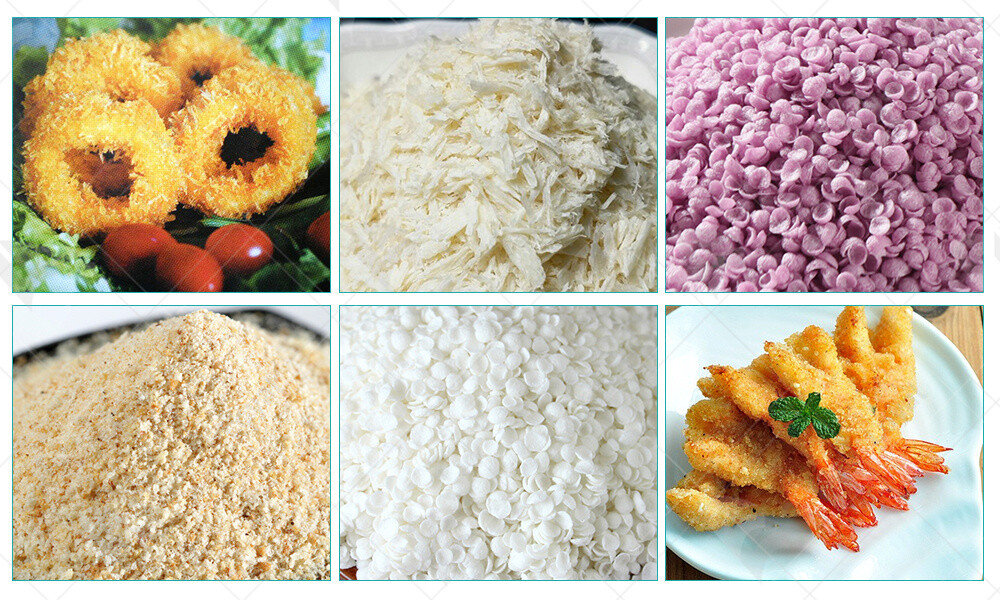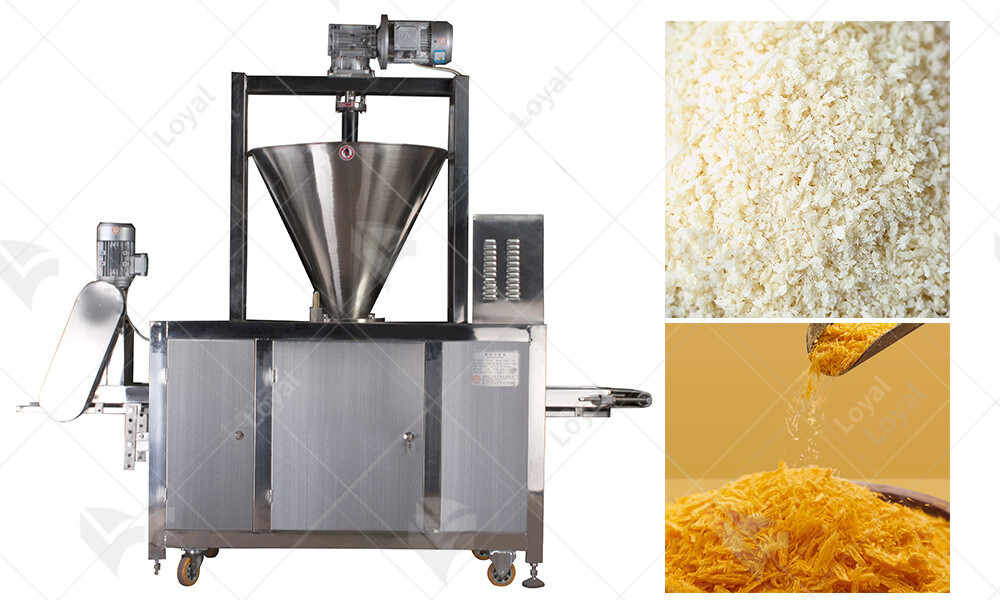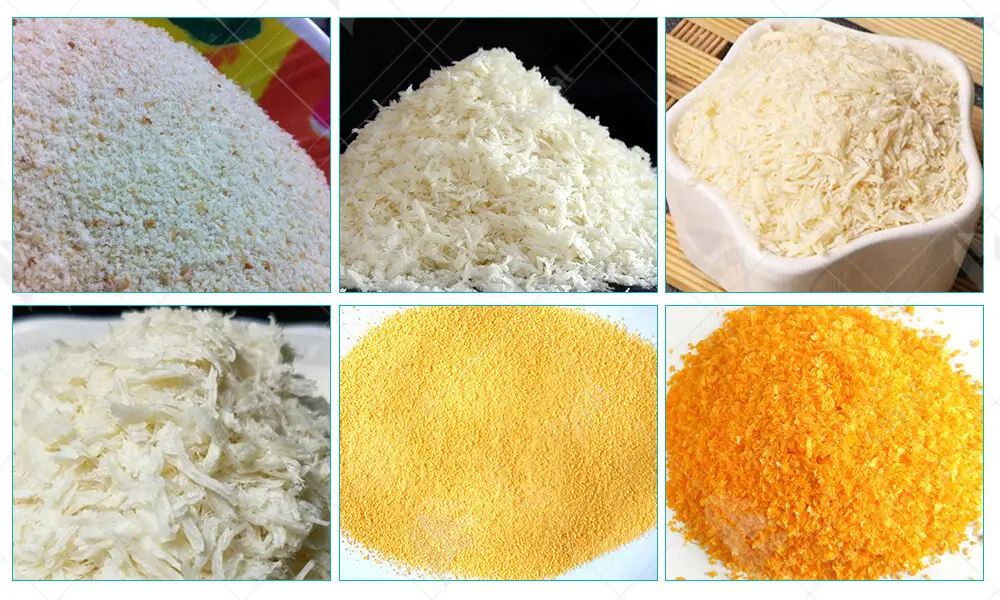Everything you need to know about panko machine japanese style bread crumb factory in 2024
Introduction
Panko breadcrumbs, characterized by their light and airy texture, have become a staple in culinary applications worldwide. Originating from Japan, these breadcrumbs are known for their ability to create a crispy coating without absorbing too much oil, making them a favorite in both professional kitchens and home cooking. In 2024, the production of panko breadcrumbs has evolved significantly, driven by advancements in food machinery and the growing demand for high-quality, consistent products.
A key player in this evolution is the panko machine, an essential component in the Japanese style bread crumb factory. These machines are specifically designed to replicate the traditional methods of making panko breadcrumbs, while enhancing efficiency, consistency, and scalability. Understanding how a panko machine works and the intricacies of setting up a Japanese style bread crumb factory is crucial for anyone looking to enter this industry or optimize their current operations.
This guide will provide a comprehensive overview of everything you need to know about panko machines and Japanese style bread crumb factories in 2024. We will explore the key components of a panko machine, the step-by-step production process, and the latest technological advancements that have transformed this industry. Additionally, we will address common challenges faced in production, offer solutions, and highlight future trends that will shape the market. Whether you are an industry professional, a new entrant, or simply curious about the production of these unique breadcrumbs, this guide will equip you with valuable insights and practical knowledge.

Key Components of a Panko Machine
In 2024, the technology behind a Panko Machine has evolved significantly, integrating precision engineering and advanced automation to streamline the production process. Below are the key components that make up a typical Panko Machine:
| Component | Description |
| Hopper | The hopper is where raw materials such as bread dough or batter are loaded. |
| Extrusion System | This system shapes and extrudes the dough into the desired breadcrumb form. |
| Cutting Mechanism | It cuts the extruded dough into uniform pieces, determining the breadcrumb size. |
| Conveyor System | Transports the freshly cut breadcrumbs through the baking and drying process. |
| Baking Oven | Bakes the breadcrumbs to achieve the characteristic crispy texture. |
| Cooling System | Cools down the baked breadcrumbs before packaging. |
| Packaging Station | Automated station for weighing, bagging, and sealing the finished product. |
| Control Panel | Centralized interface for monitoring and adjusting machine operations. |
| Cleaning System | Automated cleaning system (CIP) for maintaining hygiene standards. |
| Safety Features | Includes sensors and safety guards to protect operators during operation. |
Expanding on Other Components
Extrusion System: This component plays a crucial role in shaping the breadcrumbs. Advanced machines in 2024 feature adjustable settings for precise control over the size and shape of breadcrumbs, catering to varying market demands from fine to coarse textures.
Baking Oven: Modern ovens are equipped with state-of-the-art heating elements and airflow management systems to ensure consistent baking results. Temperature and humidity controls are integrated to achieve the ideal crispy texture without compromising on energy efficiency.
Packaging Station: In response to industry trends towards sustainable packaging, 2024 sees advancements in eco-friendly materials and automated packaging solutions. These stations incorporate smart technology for accurate portioning and labeling, meeting regulatory standards while reducing waste.
Control Panel: Leveraging Industry 4.0 principles, the control panel in contemporary Panko Machines integrates IoT capabilities for remote monitoring and predictive maintenance. Real-time data analytics optimize production efficiency and minimize downtime, enhancing overall operational performance.
Each component of a Panko Machine contributes to the efficiency and quality of the bread crumb production process, reflecting ongoing advancements in food machinery technology in 2024.

Innovations in Panko Machine Technology in 2024
In 2024, the landscape of panko machine technology has seen significant advancements, revolutionizing the efficiency and quality of Japanese style bread crumb factories. These innovations are crucial for meeting the demands of modern food production standards and enhancing overall operational capabilities.
Automated Mixing and Precision Control Systems
One of the most notable advancements in panko machine technology is the integration of automated mixing and precision control systems. These systems ensure consistent dough hydration and precise ingredient distribution, crucial for achieving uniform texture and quality in panko breadcrumbs. Automated mixers now feature enhanced programmability, allowing operators to fine-tune settings for different recipes and production volumes.
High-Speed Cutting and Drying Technologie
In 2024, panko machines have adopted high-speed cutting and drying technologies that significantly improve production efficiency. Advanced cutting mechanisms allow for precise shaping of breadcrumbs, ensuring uniformity in size and shape. Coupled with rapid drying technologies, these advancements reduce production time while maintaining optimal crispiness and texture, meeting consumer expectations for premium quality panko breadcrumbs.
Integration of IoT and Data Analytics
The integration of Internet of Things (IoT) technologies and data analytics has revolutionized the management and optimization of panko bread crumb factories. IoT sensors are now embedded throughout the production line, collecting real-time data on equipment performance, ingredient usage, and product quality parameters. This data is analyzed using advanced analytics software to identify potential inefficiencies, predict maintenance needs, and optimize production processes for maximum output and quality consistency.
Energy Efficiency and Sustainability Features
In response to global sustainability initiatives, panko machine manufacturers have focused on enhancing energy efficiency and incorporating sustainable practices. Modern machines are designed with energy-saving features such as heat recovery systems and optimized insulation, reducing overall energy consumption and operational costs. Additionally, manufacturers are increasingly using eco-friendly materials and implementing recycling programs to minimize environmental impact throughout the product lifecycle.
Enhanced User Interfaces and Remote Monitoring Capabilities
User interfaces of panko machines have been upgraded to offer intuitive controls and user-friendly interfaces. Operators can now monitor and adjust production parameters with ease, ensuring smooth operation and rapid response to changing production demands. Remote monitoring capabilities allow for real-time oversight of factory operations, enabling proactive maintenance and troubleshooting, thereby minimizing downtime and optimizing production uptime.
The innovations in panko machine technology in 2024 represent a significant leap forward in the efficiency, quality, and sustainability of Japanese style bread crumb factories. These advancements not only streamline production processes but also ensure consistent product quality and meet stringent industry standards. As technology continues to evolve, panko machine manufacturers are poised to further enhance capabilities, driving the future of food manufacturing towards greater efficiency and sustainability.

Setting Up a Japanese Style Bread Crumb Factory
Setting up a Japanese style bread crumb factory, especially one focusing on panko breadcrumbs, requires careful planning and adherence to industry standards. In 2024, the demand for high-quality panko continues to grow, necessitating advanced machinery and efficient production processes.
Essential Equipment for a Panko Factory
To operate a successful panko machine Japanese style bread crumb factory, several key pieces of equipment are indispensable. Firstly, a robust bread crumb grinder is essential for processing bread into the coarse and airy texture characteristic of panko. These grinders utilize specialized blades and screens to achieve the desired consistency without compacting the breadcrumbs.
Panko Machine: The heart of the operation is the panko machine itself, which coats the freshly ground breadcrumbs with a precise mixture of oil and seasonings before baking. Modern machines feature automated controls to ensure consistency in coating thickness and baking temperature, crucial for achieving the signature light and crispy texture.
Baking Ovens: High-capacity baking ovens are another critical component. These ovens utilize advanced heat distribution technology to uniformly bake the coated breadcrumbs to perfection. Temperature and humidity control systems ensure that each batch of panko maintains its distinct texture and flavor profile.
Packaging and Quality Control Systems: Efficient packaging systems equipped with automated weighing and sealing capabilities ensure that the finished panko breadcrumbs are promptly packaged to preserve freshness. Quality control systems, including metal detectors and visual inspection stations, guarantee that only products meeting stringent quality standards reach the market.
Factory Layout and Workflow Optimization
Optimizing the layout of a panko breadcrumb factory is vital for maximizing efficiency and minimizing operational costs. The workflow should be designed to facilitate a streamlined production process, from raw material intake to final product packaging.
Raw Material Handling: Adequate space and equipment for receiving, storing, and handling raw materials such as bread loaves are crucial. Conveyor systems and lifters streamline material flow and reduce manual handling, improving overall efficiency.
Production Line Configuration: The panko production line should be configured to minimize bottlenecks and optimize throughput. Sequential positioning of equipment, such as the grinder, panko machine, and baking ovens, ensures a continuous flow of production without unnecessary delays.
Safety and Compliance: Compliance with health and safety regulations is non-negotiable in food production. The factory layout should incorporate designated areas for sanitation stations, waste disposal, and employee amenities to promote a safe and hygienic working environment.
Compliance with Health and Safety Standards
Maintaining rigorous health and safety standards is paramount in the operation of a panko machine Japanese style bread crumb factory. Adhering to local and international regulations ensures consumer confidence and minimizes the risk of contamination or product recalls.
Sanitary Design: All equipment should be designed for easy cleaning and sanitation to prevent cross-contamination. Stainless steel construction, smooth surfaces, and accessible components facilitate thorough cleaning and disinfection processes.
Employee Training: Regular training programs for factory personnel on food safety practices and hygiene protocols are essential. Training should cover proper equipment operation, sanitation procedures, and personal protective equipment (PPE) usage to maintain a safe working environment.
Quality Assurance: Implementing a comprehensive quality assurance program guarantees that every batch of panko breadcrumbs meets established quality standards. Routine inspections, testing for product consistency and safety, and documentation of production processes are integral to quality assurance.

Challenges and Solutions in Panko Bread Crumb Production
In 2024, the operation of a Panko Machine Japanese Style Bread Crumb Factory involves navigating several challenges to ensure efficient and high-quality production. Understanding and addressing these challenges are crucial for optimizing processes and meeting market demands.
Challenge 1: Consistency in Crumb Texture
Achieving consistent texture in panko breadcrumbs is paramount for product quality and consumer satisfaction. Variations can impact the performance of the breadcrumbs in various culinary applications.
Solution: Modern panko machines utilize advanced grinding and sieving technologies to ensure uniform crumb size and texture. Innovations in blade design and material handling techniques help maintain consistency throughout the production process. Continuous monitoring and adjustment of processing parameters further enhance texture uniformity.
Challenge 2: Energy Efficiency and Sustainability
The operation of a panko bread crumb factory requires significant energy consumption, which can contribute to operational costs and environmental impact.
Solution: Implementing energy-efficient equipment such as high-efficiency ovens and automated systems for heat recovery can substantially reduce energy consumption. Integrating renewable energy sources and optimizing production schedules to minimize idle times also contribute to sustainability efforts. Moreover, adopting sustainable practices in sourcing ingredients and packaging materials supports eco-friendly operations.
Challenge 3: Maintaining Hygienic Standards
Ensuring strict adherence to hygiene and sanitation protocols is critical in food production facilities, including panko bread crumb factories, to prevent contamination and ensure product safety.
Solution: Incorporating stainless steel machinery that is easy to clean and disinfect minimizes the risk of microbial growth. Implementing regular cleaning schedules and using food-grade lubricants and cleaning agents further enhances hygiene standards. Training staff on proper hygiene practices and conducting regular audits and inspections help maintain a clean and safe production environment.
Challenge 4: Equipment Maintenance and Downtime
Equipment breakdowns and maintenance issues can disrupt production schedules and lead to delays and increased costs.
Solution: Establishing a proactive maintenance schedule with regular inspections and preventive maintenance measures can mitigate the risk of unexpected downtime. Maintaining an inventory of critical spare parts and components ensures quick replacement and minimal disruption to operations. Utilizing predictive maintenance technologies that monitor equipment performance in real-time can identify potential issues before they escalate into major problems.
Challenge 5: Market Demand and Customization
Meeting diverse market demands and adapting to varying customer preferences require flexibility and agility in production processes.
Solution: Implementing modular and customizable panko machine configurations allows for efficient adaptation to different product specifications and market demands. Investing in research and development to innovate new breadcrumb variations and flavors can attract new consumer segments and strengthen market competitiveness.

Sustainability and Eco-Friendly Practices
In 2024, sustainability is a cornerstone of modern manufacturing, especially in the realm of food production machinery such as panko machines and Japanese style bread crumb factories. These facilities are increasingly adopting eco-friendly practices to minimize their environmental footprint while maintaining efficient production standards.
Sustainable Ingredients and Sourcing
The foundation of any eco-friendly panko breadcrumb factory begins with sustainable ingredient sourcing. Manufacturers are prioritizing the use of responsibly harvested wheat and other grains, ensuring that raw materials are sourced from suppliers who adhere to sustainable agricultural practices. This not only supports environmental conservation but also promotes ethical sourcing within the food industry.
Example: At XYZ Panko Machines, we procure our wheat from local farms certified by sustainable agriculture programs. By sourcing locally, we reduce transportation emissions and support the local economy.
Energy Efficiency and Waste Reduction
Energy consumption is a significant consideration in the operation of panko machines and bread crumb factories. To minimize environmental impact and reduce operational costs, manufacturers are investing in energy-efficient technologies and practices. This includes the use of advanced ovens with precise temperature controls, LED lighting systems, and the integration of renewable energy sources where feasible.
Example: Our state-of-the-art panko machine utilizes energy-efficient baking technologies and heat recovery systems to optimize energy usage. This not only lowers our carbon footprint but also contributes to substantial cost savings over time.
Certifications and Green Manufacturing Practices
Adhering to rigorous environmental standards and obtaining relevant certifications is crucial for demonstrating commitment to sustainability. Many panko machine manufacturers are obtaining certifications such as ISO 14001 for environmental management and LEED (Leadership in Energy and Environmental Design) for green building practices. These certifications not only validate sustainable manufacturing processes but also enhance brand reputation and appeal to environmentally conscious consumers.
Example: We are proud to be certified under ISO 14001, ensuring that our operations meet stringent environmental performance standards. Our commitment to sustainable practices extends to every aspect of our manufacturing process, from design to delivery.
Waste Management and Recycling Initiatives
Effective waste management is another key component of eco-friendly practices in panko breadcrumb production. Manufacturers are implementing comprehensive recycling programs to minimize waste generation and maximize resource efficiency. This includes recycling packaging materials, composting organic waste, and repurposing by-products for secondary applications.
Example: Through our comprehensive waste management program, we recycle over 90% of our production waste, including packaging materials and leftover breadcrumbs. By turning waste into valuable resources, we reduce landfill contributions and promote a circular economy.
Employee Engagement and Sustainability Education
Creating a culture of sustainability within the workforce is essential for maintaining eco-friendly practices in the long term. Manufacturers are investing in employee training programs focused on sustainability awareness and best practices. By empowering employees to participate in sustainability initiatives, companies foster a collective commitment to environmental stewardship throughout the organization.
Example: We conduct regular training sessions to educate our team members on the importance of sustainability and their role in achieving our environmental goals. Employee feedback and ideas are integral to continuously improving our eco-friendly initiatives.

References
Here are some authoritative international websites for academic literature focused on industrial food machinery and food engineering:
1. ScienceDirect
Website: https://www.sciencedirect.com/
2. SpringerLink
Website:https://link.springer.com/
3. Wiley Online Library
Website:https://onlinelibrary.wiley.com/
4. PubMed
Website: https://pubmed.ncbi.nlm.nih.gov/
5. Taylor & Francis Online
Website:https://www.tandfonline.com/












